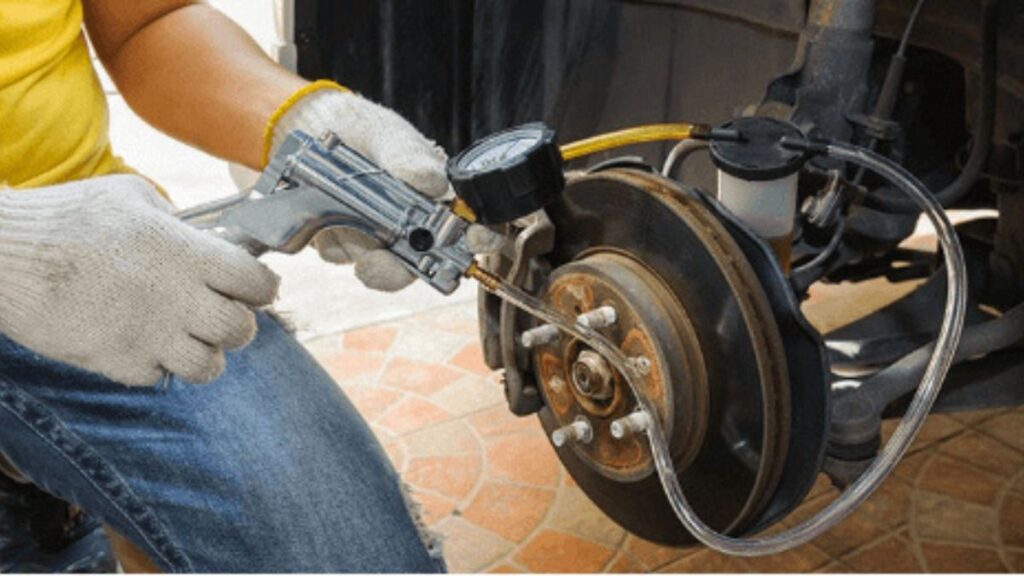Brake issues are some of the most important to address quickly since they directly affect your safety. However, many drivers get confused when it comes to terms like brake bleeding versus brake replacement. While both involve the braking system, they serve very different purposes. Understanding the difference helps you know which service your vehicle needs and prevents unnecessary repairs.
Sometimes all you need is a simple brake bleed to remove air bubbles from your lines. Other times, worn parts require a full replacement. Having the right tools, like a brake bleeder kit, and knowing the warning signs can help you decide which path is best for your situation.
What Is Brake Bleeding?
- Why Brake Bleeding Matters
Your brakes work through hydraulic pressure. When you press the brake pedal, fluid travels through lines to apply force on calipers or wheel cylinders, which then press the pads or shoes against rotors or drums. If air enters the system, it compresses under pressure, reducing braking efficiency. That’s where brake bleeding comes in. - The Process
Brake bleeding removes trapped air bubbles from the brake lines. Using a brake bleeder kit, fluid is forced through the system until the lines are free of air. This restores firm pedal feel and ensures proper hydraulic pressure. - When It’s Needed
Common signs you need brake bleeding include a spongy or soft brake pedal, longer stopping distances, or reduced responsiveness. Air can enter the system during brake repairs, after fluid changes, or through small leaks. - Tools You’ll Need
In addition to a bleeder kit, you’ll need brake fluid, wrenches for the bleeder valves, and a clear hose to monitor air bubbles. While the process can be DIY-friendly, it requires attention to detail to avoid introducing more air. - Preventive Benefits
Bleeding your brakes periodically — even without obvious issues — helps maintain consistent brake performance. It also gives you a chance to flush out old fluid, which can absorb moisture over time and reduce braking efficiency.
What Is Brake Replacement?
- Components That Wear Out
Unlike brake fluid, which just needs air removed, physical parts of your braking system wear down and eventually need replacement. This includes pads, rotors, calipers, and hardware. Installing the best brake pads ensures strong stopping power and longer life. - Signs You Need Replacement
Squealing noises, grinding sounds, vibration when braking, or a dashboard warning light are all signs that replacement may be necessary. Pads wear down with use, rotors can warp, and calipers may seize if not maintained. - The Process
Brake replacement involves removing worn components and installing new ones. Pads are the most commonly replaced part, while rotors and calipers may also need attention depending on wear. For example, if a caliper seizes, a disc brake caliper repair kit may restore proper function without requiring a full replacement. - Safety Implications
Unlike bleeding, which restores hydraulic efficiency, replacement addresses mechanical wear. Ignoring worn pads or rotors compromises braking distance and increases the risk of accidents. Replacement ensures your system performs safely under all driving conditions. - Cost and Effort Differences
Bleeding brakes is generally quicker and less expensive than replacement. However, if parts are worn, bleeding alone won’t fix the issue. Regular inspections help you catch problems early and avoid more expensive repairs later.
Final Thoughts
Brake bleeding and brake replacement may sound similar, but they address completely different issues. Bleeding removes air to restore hydraulic efficiency, while replacement restores worn-out components to keep your system working safely.
Knowing which service your car needs comes down to recognizing symptoms. A soft pedal often points to air in the lines, while grinding noises or vibrations indicate worn parts. By using the right tools and staying on top of maintenance, you can keep your braking system safe, responsive, and ready for the road.





